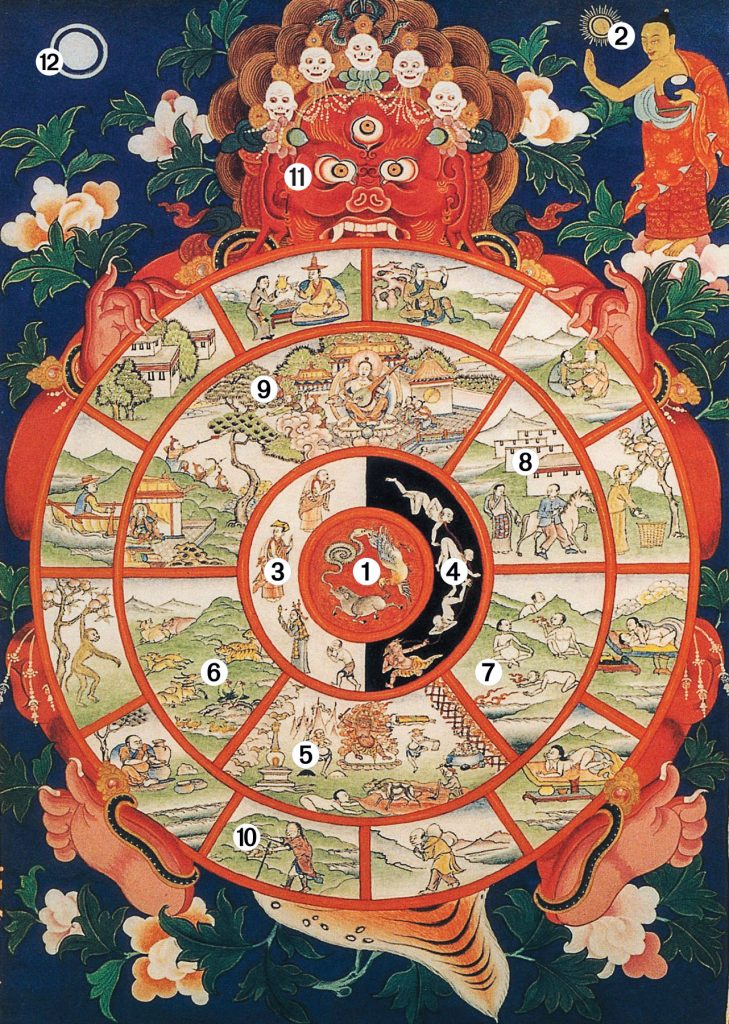The bhavacakra, the “wheel of existence,” or “wheel of birth and death,” found painted on the walls outside Tibetan Buddhist temples in Tibet, India, and China, goes back to a text from an early Indian school preserved in Chinese and Tibetan translations (the Mulasarvastivada-vinaya vibhanga). The text explains how it came about that the Buddha asked for the wheel to be painted and gives the blueprint provided for rendering the image.
Maudgalyayana, one of the Buddha’s two main disciples, after periodically traveling through the realms of existence would return to describe them, inspiring those he addressed to make efforts to follow the Buddha’s teachings. For the benefit of those who would not be able to hear Maudgalyayana, the Buddha said that the wheel of life should be painted outside the front entrance to temples and that a monk should be appointed to explain the painting to pilgrims. The bhavacakra, it should be noted, was in the beginning always a mural, not a thangka, or scroll painting.
Visually, the wheel contains several distinct parts. While there are many variations, the following sections are most common and can be seen in the image to the left, starting at the center and moving outward: the three poisons; good and bad karma; the five or six realms of existence; the twelve links of causation, or dependent origination; and, holding the wheel, a demon representing impermanence.
The instruction stipulated that a Buddha should be at the center of the wheel, with a pig, a snake, and a bird ➊ (representing the three poisons of ignorance, aversion, and attachment, respectively) placed in front of him. However, this configuration is extremely rare: early on in the wheel’s depictions the Buddha figure was moved to the upper right corner ➋, outside the wheel itself, in what appears to be a Tibetan innovation. In the earliest extant wheel of life—from the 4th or 5th century CE, in the Ajanta Caves in India—the original instruction is followed; but in the version shown in our illustration, the central circle or disk contains only the representation of the three poisons.
The next segment is a white and black disk. The white section represents meritorious actions (which are moving upward toward the top of the circle) ➌. The black half shows bad actions (moving downward toward the bottom) ➍. In the source text the Buddha likens this to a water wheel with buckets going up one side and down the other, a depiction seen in some examples of the wheel in China.
Whether we know it or not, we’re all on the wheel—at least until we get enlightened.
Next are the realms of existence. Naraka (Skt., “hell”) is at the bottom ➎. On the next level are animals on one side ➏ and ghosts on the other ➐. Above them are the human realm ➑ and the gods’ realm ➒. In the Nyingma tradition, one of the four main schools of Tibetan Buddhism, bhavacakras are most likely to depict six realms, as described in the Guhyagarbha Tantra (the primary text studied by this school), where the gods’ realm is split into two: devas (the gods) and asuras (jealous demigods); in the latter realm there is no dharma and no opportunity for enlightenment.
In the final ring, outside the realms of existence, are the twelve links of dependent origination, beginning with ignorance, here represented by a blind person with a walking stick ➓.
The Buddha also mentions a fearsome, ugly creature that embraces the wheel⓫—the demon of impermanence, as the Chinese translation names him. The demon is not Yama, the lord of death, although that is who he is commonly held to be; Yama’s presence would place undue emphasis on death. In the Tibetan artistic tradition, it has become the custom to adorn the demon with ornaments such as a crown, earrings, jewelry, and a tiger-skin skirt, as if it were a wrathful deity like Mahakala or Vajrapani. Many teachers, including the Dalai Lama, believe that such complimentary decoration is inappropriate for a demon. Some traditions, such as the Mongolian, generally do not decorate the demon.
The Buddha said also that the upper corner of the painting should show two verses describing the purity of nirvana, which is represented by a white sphere⓬. This last symbolic element is sometimes painted as a moon, and Tibetans therefore often paint a rabbit on it, after a well-known Jataka story featuring a pure-hearted rabbit whose image is inscribed on the moon. The Buddha figure is seen in the corner opposite the moon, because having achieved nirvana, he is free of the wheel.
When looking at a bhavacakra, it doesn’t really matter where you start on the wheel, but it does matter that you go clockwise when observing the twelve links of dependent origination.
You will see many variations of the bhavacakra, but most will contain the same essential features discussed here. Whether we know it or not, we’re all on the wheel—at least until we get enlightened and can hop off at the top like the Buddha!
Thank you for subscribing to Tricycle! As a nonprofit, we depend on readers like you to keep Buddhist teachings and practices widely available.
